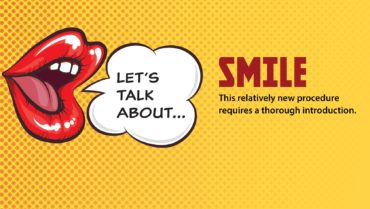
Small incision lenticule extraction (SMILE) is a recent innovation in laser refractive surgery. Performed with the VisuMax femtosecond laser (Carl Zeiss Meditec), the procedure involves creation of a disc-shaped lenticule in the corneal stroma and removal of that lenticule through a 2-mm incision, leaving the corneal surface principally untouched. The minimally invasive procedure requires only one laser to change the profile of the cornea, unlike femtosecond LASIK, in which a femtosecond laser is used to cut a stromal flap and then an excimer laser for tissue ablation. Today, SMILE is indicated for reduction of myopia up to approximately -8.00 D with less than 0.50 D cylinder. To date, it cannot be used for astigmatic or hyperopic treatments.
SMILE is a gentle treatment, offering rapid recovery from laser vision correction thanks to the tiny self-sealing incision. Patients can generally return to leisure activities the following day and contact sports 3 days after surgery.
Although relatively new, SMILE has already become an established laser vision procedure for the correction of myopia, having been performed in more than 750,000 eyes worldwide since its introduction in 2011, according to the laser manufacturer.1 Cathedral Eye Clinic in Belfast introduced Ireland’s first VisuMax laser for SMILE surgery.2
Because it is a relatively new refractive surgical procedure, we have our work cut out for us educating patients about SMILE’s capabilities and informing them about its risks and benefits. This article outlines how we introduce the procedure to our patients who are candidates for laser vision correction with SMILE. In the accompanying sidebar, I provide answers to the five questions most often asked about SMILE. A sample answer from the first page of a Google search of the same question is also provided.
INTRODUCING SMILE
At Cathedral Eye Clinic, our patients have their initial suitability consultation with one of our optometrists. After a full examination, if the patient is deemed a candidate for SMILE, the optometrist then begins to explain to the patient the surgery process, benefits, alternatives, and risks involved as part of the consent.
We use diagrams to explain the surgical process to the patient (Figures 1 and 2), along with a short animated video clip. We also present and explain a thorough list of potential risks and complications of SMILE, including infection, which could lead to sight threatening complications; subconjunctival hemorrhage; delayed healing; under- or over-correction; abrasion; epithelial ingrowth; glare and halos; and ectasia, which can require treatment with CXL.
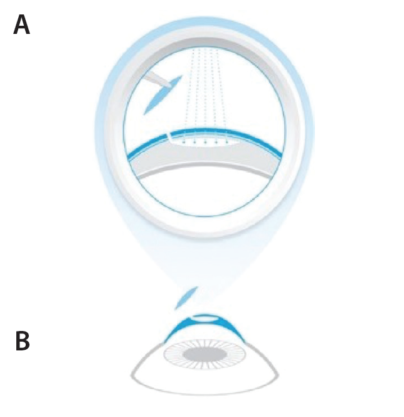
Figure 1. Illustration used for patient education. The femtosecond laser creates a lenticule within the stroma (A). The lenticule is then removed through a 2-mm incision, leaving the corneal surface principally untouched (B).
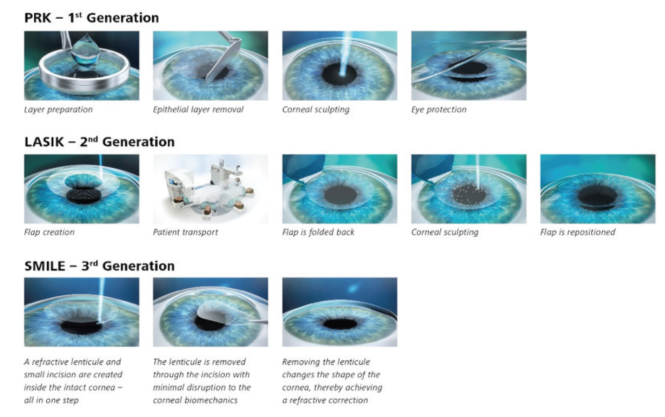
Figure 2. This graphic used for patient education explains the evolution of laser refractive surgery from PRK to LASIK to SMILE.
The consultant ophthalmologist addresses these points one by one and actively discusses them with the patient. The ophthalmologist also writes and draws diagrams that the patient can understand easily, resulting in a detailed copy of the firsthand information that has been given to the patient and documentation of the consent discussion between surgeon and patient.
INFORMED CONSENT
After the consent discussion, a full consent form is given to the patient that again outlines what has been discussed. A portion of the consent form used by Cathedral Eye Clinic, which requires the patient’s signatures in multiple places, is found in Figure 3. Following is a summary of some of its points:
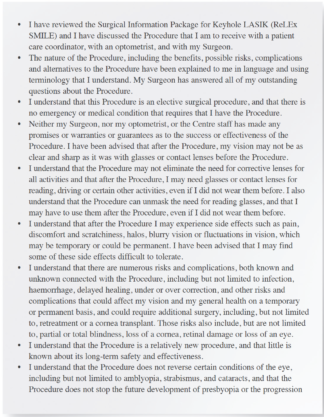
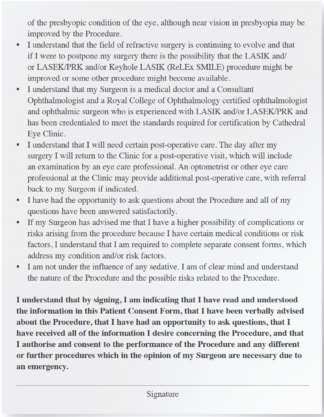
Figure 3. The informed consent form used at Cathedral Eye Clinic.
• The patient affirms that he or she has reviewed the surgical information package for SMILE and discussed the procedure with a patient care coordinator, an optometrist, and his or her surgeon;
• It is made clear that the procedure is elective, that the surgery may not eliminate the need for corrective lenses for all activities, and that vision may not be as clear and sharp after the procedure as it was with correction before the procedure;
• Potential side effects such as pain, discomfort, scratchiness, halos, blurry vision, or fluctuations in vision, which may be temporary or permanent and may be difficult to tolerate, are detailed. Risks and complications are catalogued, the possibility that additional surgery may be required is outlined, and the potential risk of blindness is acknowledged;
• The form points out that SMILE is a relatively new procedure, and little is known about its long-term safety and effectiveness; and
• The form also indicates that the surgeon who will perform SMILE is a medical doctor and a consultant ophthalmologist certified by the Royal College of Ophthalmology. The surgeon is experienced with LASIK and PRK and has been credentialed to meet the standards required for certification by Cathedral Eye Clinic.
Question No. 1: Is SMILE painful?
Professor Moore: No, patients report that they either are pain-free or experience mild discomfort after SMILE surgery. On occasion, patients may feel some discomfort after surgery for a day or so, but this is completely normal and quickly disappears.
Google hit No. 2: The SMILE procedure is not painful. In fact, patients are often surprised to find that it’s completed so quickly and with so little discomfort!1
1. https://brintonvision.com/faq-items/is-smile-painful/
Question No. 2: What is the recovery time?
Professor Moore: You will see pretty well the next day after surgery, and you can return to leisurely activities that day and even to contact sports within 3 days after surgery. As each week passes, your vision will gradually improve.
Google hit No. 2: Your vision may be blurry right after SMILE surgery. As you heal over the next few days and weeks, your vision will gradually improve. You can do most normal activities after a day or two. Avoid getting water in your eyes for a few days.1
1. https://www.aao.org/eye-health/treatments/what-to-expect-with-smile
Question No. 3: How long does the surgery take?
Professor Moore: You will be in the operating room for approximately 40 minutes if you receive treatment to both eyes. The laser itself acts on the eye for only about 25 seconds.
Google hit No. 5: The whole treatment usually takes between 10 to 15 minutes, the actual laser is in operation for only a tiny fraction of this time, and after a quick postoperative check by your surgeon, you are free to go.1
1. https://www.sheffieldvisioncentre.co.uk/laser-eye-surgery/relex-flexsmile-eye-surgery
Question No. 4: What are the risks involved?
Professor Moore: We have fully outlined the risks during our consent discussion and on the full consent form. To reiterate what we talked about before, the main risks relating to SMILE surgery include, but are not limited to, infection, which could lead to sight-threatening complications; subconjunctival hemorrhage; delayed healing; under- or over-correction; abrasion; epithelial ingrowth; glare and halos; and ectasia, which can require treatment with a procedure called CXL. The threat of these risks is minimal; however, glare and halos are common in the first 1 to 2 months.
Google hit No. 1: Complications arising during the SMILE procedure have been reported very infrequently, supporting the reported safety and predictability of the procedure. Studies using SMILE found epithelial abrasions, small tears at the incision, and perforated caps in a few cases, however, none of these patients had late visual symptoms. The loss of suction during the femtosecond laser portion of the procedure is one of the primary complications with SMILE, and seems to be a difficult topic to define care that applies to most or all cases. While noted to be very infrequent, one study showed the majority of cases in which suction loss occurred were able to be reapplied in the same setting (81.8%). The rest of the suction loss cases were aborted, though, it should be noted that for all cases involving suction-loss, there remained a significant number of patients that attained UDVA within attempted correction. Because a small incision (2–3 mm) is used in place of an entire flap, corneal nerve severance is minimal in comparison to LASIK. This coincides with the decreased occurrence of postoperative dry eye and studies have indeed shown an increase in nerve reinnervation after treatment.1
1. http://eyewiki.aao.org/Small_Incision_Lenticule_Extraction_(SMILE)
Question No. 5: Are the results permanent?
Professor Moore: The results are not permanent; however, the changes made during the procedure are. The reason that I say the results are not permanent is because, due to our natural aging process, over time your vision may deteriorate slightly. These minor shifts generally occur after the age of 50, and the change is on average 0.50 D every decade. They are to be expected in a healthy human. If they are a concern for you, they can even be corrected with follow-up surgery.
Google hit No. 4: The VisuMax femtosecond laser removes a small amount of eye tissue to permanently reshape the cornea. A femtosecond (very fast, short-pulsed) laser makes cuts within the cornea, creating a disc-shaped piece of tissue that is removed by the surgeon through a small incision in the surface of the cornea. This tissue removal causes the shape of the cornea to change, which corrects the nearsightedness.1
1. https://www.fda.gov/NewsEvents/Newsroom/PressAnnouncements/ucm520560.htm
CONCLUSION
With the information that the staff relays to the patient verbally, through diagrams and videos, and with the written informed consent, and with the good reputation and high standing of the Cathedral Eye Clinic in the community, the patient knows that he or she is in capable hands and that our team will do its best to deliver maximal surgical and postoperative care.
Our experience with SMILE to date has been positive, and we look forward to improving the uncorrected vision of many patients with this and other future laser vision correction technologies.
1. First SMILE Laser eye surgery procedures for U.S. Navy performed at Naval Medical Center San Diego [press release]. Carl Zeiss Meditec. April 19, 2017. https://www.zeiss.com/meditec/us/media-and-news/latest-news/first-smile-laser-eye-surgery-procedures-for-u-s-navy-performed-at-naval-medical-center-san-diego.html. Accessed June 1, 2017.
2. Zeiss receives US FDA approval for VisuMax SMILE vision correction procedure, the latest advancement in laser eye surgery [press release]. Carl Zeiss Meditec. September 14, 2016. https://www.zeiss.com/meditec/us/media-and-news/latest-news/fda-approves-zeiss-visumax-smile.html. Accessed June 1, 2017.


